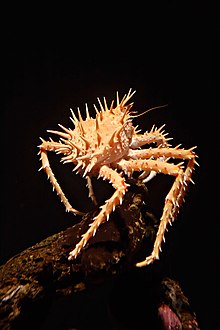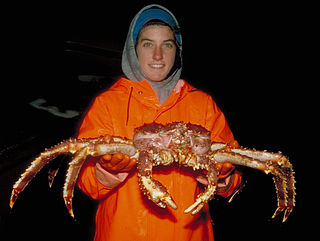
Alaskan king crab fishing is carried out during the fall in the waters off the coast of Alaska and the Aleutian Islands. The commercial catch is shipped worldwide. Large numbers of king crab are also caught in Russian and international waters.

The red king crab, also called Kamchatka crab or Alaskan king crab, is a species of king crab native to cold waters in the North Pacific Ocean and adjacent seas, but also introduced to the Barents Sea. It grows to a leg span of 1.8 m (5.9 ft), and is heavily targeted by fisheries.
Echidnocerus is a genus of king crab. It includes Echidnocerus foraminatus and Echidnocerus cibarius, the Puget Sound king crab. The genus was long known as Lopholithodes until it was discovered in 2022 that Lopholithodes is a junior synonym of Echidnocerus.

The Puget Sound king crab, is a species of king crab which inhabits the oceans of the Pacific coast of North America from Alaska to central California. Adults are orange, red and purple in color, while juveniles are either mostly orange or have small blotches of red and purple. They can be recognized by their blunt bumps on their carapace. Puget Sound king crabs are larger than the similar brown box crab, with an average size of 6–10 inches (15–25 cm).

Paralomis is a genus of king crabs. It includes the following 69 species:

Paralithodes platypus, the blue king crab, is a species of king crab from cold waters in the North Pacific Ocean and adjacent seas. Although blue king crabs are among the largest crabs in the world and reputedly may exceed 18 pounds (8.2 kg) in weight, they are generally smaller than red king crabs.

Lithodes is a genus of king crabs. Today there are about 30 recognized species, but others formerly included in this genus have been moved to Neolithodes and Paralomis. They are found in oceans around the world, ranging from shallow to deep waters, but mostly at depths of 100–1,000 m (300–3,300 ft). They are restricted to relatively cold waters, meaning that they only occur at high depths at low latitudes, but some species also shallower at high latitudes. They are medium to large crabs, and some species are or were targeted by fisheries.

Neolithodes is a genus of king crabs, in the family Lithodidae. They are found in all major oceans, both in high and low latitudes. Although there are records from water as shallow as 124 m (407 ft) in cold regions, most records are much deeper, typically 700–2,000 m (2,300–6,600 ft), with the deepest confirmed at 5,238 m (17,185 ft). They are fairly large to large crabs that typically are reddish in color and spiny, although the size of these spines varies depending on species.
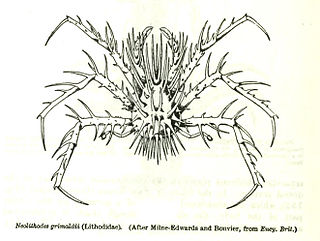
Neolithodes grimaldii, the porcupine crab, is a species of king crab in the family Lithodidae. This large red crab is found in cold deep waters in the North Atlantic and often caught as a bycatch in fisheries for Greenland turbot. As suggested by its common name, the carapace and legs are covered in long spines.
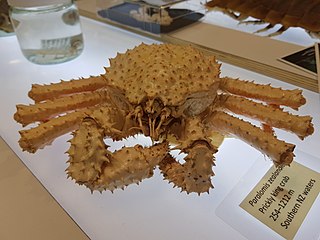
Paralomis zealandica, also known as the prickly king crab, is a species of king crab which lives at a depth of 254–1,212 m (833–3,976 ft) in New Zealand. It has spiky carapace. The scientific name of the species was first validly published in 1971 by Dawson & Yaldwyn. P. zealandica can be distinguished from other species in New Zealand waters by its thick covering of strong upright spines all over, including on its abdomen and along its legs and claws. The rostrum has three short, strong and sharp spines. It is the most prominent species of Paralomis in New Zealand.

Neolithodes agassizii is a species of king crab native to the Western Atlantic. They live at depths of 200–1,900 metres (660–6,230 ft), and have been found as far south as Rio de Janeiro, as far north as latitude 36°, and near the Equator. It has been found in the southwestern Caribbean Sea as well as the Gulf of Mexico.
Neolithodes yaldwyni is a species of king crab which is found in the Ross Sea from depths of 124–1,950 metres (407–6,398 ft). It had previously been misidentified as Neolithodes brodiei, and it closely resembles Neolithodes capensis.
Neolithodes asperrimus is a species of king crab native to the coast of Africa. It has been found in South Africa and Mauritania at depths of 997–1,862 metres (3,271–6,109 ft), and Neolithodes aff. asperrimus has been found in Madagascar, Réunion, and the South Region of Brazil.
Neolithodes capensis is a species of king crab which is found in the Southern Ocean and the western Indian Ocean. It has been found to a depth of 660–3,200 metres (2,170–10,500 ft).

Neolithodes diomedeae is a species of king crab which is found in the eastern Pacific Ocean, the southwestern Atlantic Ocean, and the Bellingshausen and Scotia Seas in the Southern Ocean. They occur from 200 to 2,454 m.
Neolithodes nipponensis is a species of king crab which is found in Japan and Taiwan. It has been found at depths from 200–1,752 metres (656–5,748 ft).
Neolithodes duhameli is a species of king crab which is found in the Crozet Islands in the southwestern Indian Ocean from a depth of 620–1,500 metres (2,030–4,920 ft).
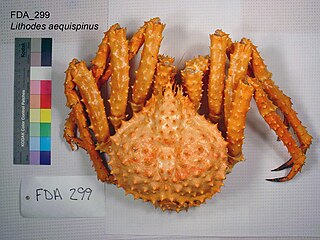
Lithodes aequispinus, the golden king crab, also known as the brown king crab, is a king crab species native to the North Pacific. Golden king crabs are primarily found in the Aleutian Islands and waters nearer to Alaska and British Columbia; their range also extends to the Russian far east and Japan, albeit with a less dense population. Golden king crabs are the smallest of the three commercially viable Alaskan king crab species with an average weight between 5 and 8 lbs ; the other two species being the blue and red king crabs. Golden king crabs were historically caught incidentally in red king crab fisheries, but the first commercial landing took place in 1975; in 1981, the targeted pot-fishing method, a hybrid fishing method specifically for golden king crab, was developed.
Lithodes longispina is a species of king crab. It has been found in Japan and Taiwan. Before 2010, its reach was thought to be much greater than presently understood, such as Australia, New Zealand, and Guam. It has also allegedly been sighted in the Northwestern Hawaiian Islands.
